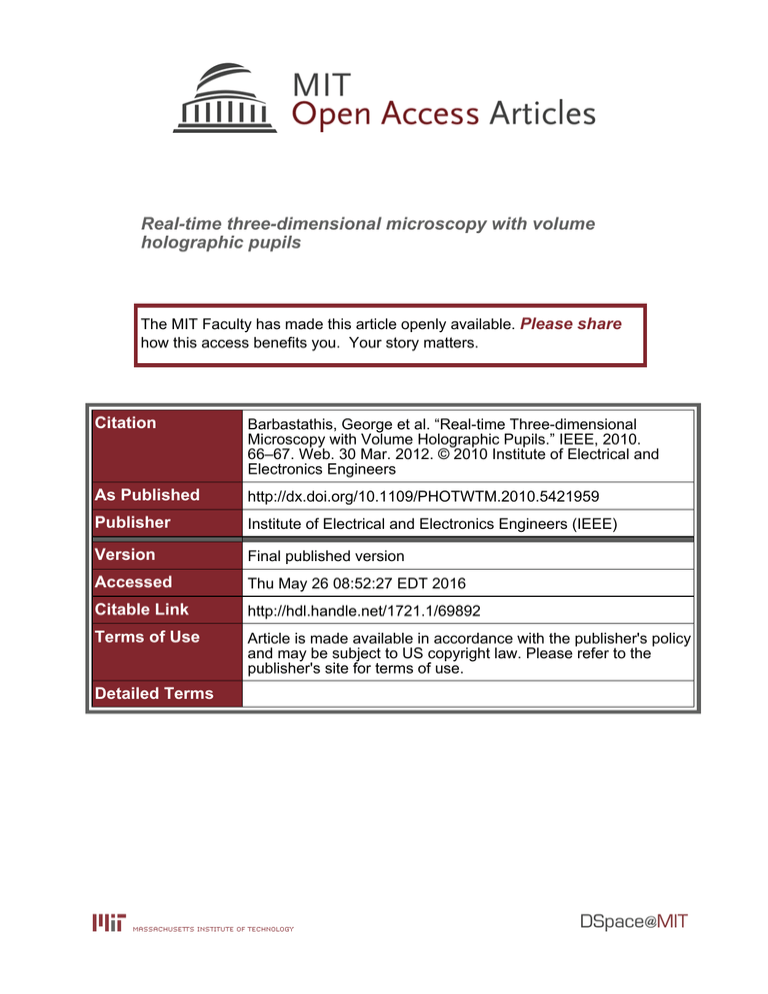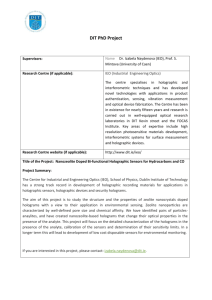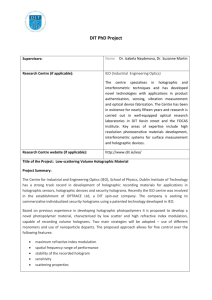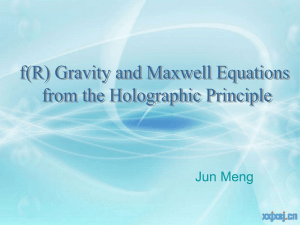Real-time three-dimensional microscopy with volume holographic pupils Please share
advertisement

Real-time three-dimensional microscopy with volume holographic pupils The MIT Faculty has made this article openly available. Please share how this access benefits you. Your story matters. Citation Barbastathis, George et al. “Real-time Three-dimensional Microscopy with Volume Holographic Pupils.” IEEE, 2010. 66–67. Web. 30 Mar. 2012. © 2010 Institute of Electrical and Electronics Engineers As Published http://dx.doi.org/10.1109/PHOTWTM.2010.5421959 Publisher Institute of Electrical and Electronics Engineers (IEEE) Version Final published version Accessed Thu May 26 08:52:27 EDT 2016 Citable Link http://hdl.handle.net/1721.1/69892 Terms of Use Article is made available in accordance with the publisher's policy and may be subject to US copyright law. Please refer to the publisher's site for terms of use. Detailed Terms TuB3.1 (Invited) 13:30 - 14:00 Real-time three-dimensional microscopy with volume holographic pupils George Barbastathis,1,2 Yuan Luo,1 Se-Baek Oh,1 and Raymond K. Kostuk3 1 2 Department of Mechanical Engineering Massachusetts Institute of Technology Cambridge, Massachusetts 02139 Singapore-MIT Alliance for Research and Technology (SMART) Centre Singapore 117543 3 Corresponding author’s e-mail address: gbarb@mit.edu Abstract—Multiplex volume holographic pupils have been demonstrated in the capacity of imagers with optical slicing and real-time (scanning-free) three-dimensional imaging capability. We overview application to microscopy and describe methods to improve depth resolution and contrast. II. INTRODUCTION A volume holographic pupil is a three-dimensional dielectric modulation on one or several multiplexed spatial carriers placed at the pupil (Fourier) plane of an imaging system. If the modulation consists of a single carrier, then it endows the imaging system with “optical slicing,” i.e. depth rejection capability [1]. By multiplexing several carriers of different spatial frequencies and curvatures onto the same pupil, it becomes possible to selectively image the corresponding depth slices simultaneously on non-overlapping areas of a camera [2]. Thus, the entire 3D specimen becomes visible in real time, i.e. without any scanning requirement. Figure 1(b) shows how the multiplex volume holographic pupil functions in an imaging system [2,4]. Consider a quasimono-chromatic spatially incoherent volumetric source centered around the focal plane of the objective lens. (A fluorescent tissue specimen is to a good approximation such a source.) For each location used as origin of the spherical wave references that recorded the pupil, the light originating from a small volume of the specimen around that location will Bragg match the corresponding hologram that was multiplexed in the pupil and produce a diffracted beam that propagates in the direction of the corresponding signal plane wave. According to the degeneracy properties of volume gratings, the Braggmatched portion of the specimen is shaped like a column oriented vertically with respect to the optical axis and extended along the degeneracy plane, i.e. perpendicular to the axes of the corresponding reference and signal beams. Volume holographic pupil technology is an outgrowth of holographic data storage. In the latter, thousands of data pages were multiplex-stored into a single spot of volume holographic material [3]. Components of that research included optical system design for the delivery of the reference and signal beams to the hologram; material research for maximizing and equalizing the diffraction efficiencies of the holograms sharing the volume; and channel and error-correction coding for maximizing the stored information. Volume holographic imaging pupils are simpler because they require fewer exposures and the signal beams are spherical waves. Therefore, many of the challenges still facing holographic data storage are absent from our efforts. However, new challenges have emerged relating to optimization of image contrast, especially in specimens of high value for medical applications, such as highly scattering tissue. In this paper we review the basics of volume holographic pupils and describe two recent techniques based on phase contrast and depth-wavelength encoding that we developed in our laboratories to address these challenges. 978-1-4244-5241-5/10/$26.00 ©2010 IEEE MULTIPLEX VOLUME HOLOGRAPHIC PUPILS Figure 1(a) shows the basic arrangement for the recording of a multiplex volume holographic pupil [2,4]. The holographic material is placed at the pupil (Fourier) plane of a telescope (4F) system and sequentially exposed to pairs of reference and signal beams. The reference beams are spherical waves originating at progressively increasing distances away from the focal plane of the 4F objective; we typically select one of these to be placed exactly at the focal plane (thereby producing a plane wave reference for its corresponding exposure) and displace the remaining ones symmetrically around it. The signal beams are plane waves, each oriented at a different angle with respect to the hologram axis. Therefore, in the simplest implementation the multiplex volume holographic pupil consists of a superposition of spherical-to-plane wave holograms. Keywords-3D optics, volume holography, optical microscopy. I. Department of Electrical and Computer Engineering and College of Optical Sciences The University of Arizona Tucson, Arizona 85719 The collector lens placed in the path of the diffracted beam focuses the light produced by the Bragg-matched portion and produces an in-focus image of that portion onto the CCD camera. By judiciously selecting the directions of the plane waves recording the multiplex holograms such that the corresponding images do not overlap on the camera, we may 66 (b) Figure 1 (a) Recording and (b) imaging with a volume holographic pupil. fo: focal length of objective lens; s,A, s,B: recording angles for the signal plane p y and propagation p p g g for the images formed by visible columns A and B, respectively. waves of exposures A and B, respectively, angles (a) (b) Figure 2 Contrast improvement using single sideband modulation: Image of the same onion skin specimen (a) without and (b) with the edge-enhancing single sideband filter (knife edge.) (a) (b) (c) Figure 3 Wavelength encoded images from multiple depths (blue, surface; red, 100μm below) within the same onion skin specimen (a) with both LEDs on; (b) with the blue on and red off; (c) with the red on and blue off. image the corresponding axial specimen cross-sections simultaneously. improved simultaneously in both imaged depths within the specimen. The multiplex holograms as described during the recording step have axial (depth) slicing capability, again due to their Bragg properties. The wavefronts originating at a specimen portion that Bragg-matches a certain hologram fail to Braggmatch the remaining holograms. This property is similar to the confocal microscopy using a slit to eliminate out-of-focus light. Unfortunately, due to spatial Bragg degeneracy it is not possible to emulate confocal microscopy with a pinhole (which would have given maximum contrast.) Nevertheless, the simultaneously obtained images from the axial cross-sections are mostly free from defocus light due to the background from the thick specimen, but the contrast does decrease as the source bandwidth increases due to color Bragg degeneracy. B. Wavelength Coded Volume Holographic Pupil [6] To reduce color crosstalk due to Bragg degeneracy, we used different color LEDs to match holograms corresponding to selected depths. Again, contrast improved as seen in Figure 3. Moreover, this approach allows us to better match the specimen properties, e.g. we can use the red color to image deeper since it penetrates better. IV. CONCLUSIONS Optical microscopy with multiplex volume holographic pupils is promising for real-time imaging applications where scanning is unacceptable, especially given our recent progress in contrast enhancement techniques. Future directions include the adaptation of more general pupil engineering methods to multiplex volume holographic pupils, and exploitation of color Bragg degeneracies for hyperspectral imaging. CONTRAST IMPROVEMENTS FOR THREE-DIMENSIONAL MICROSCOPY Contrast is the most important quality criterion to successfully apply this technique to biological or medical microscopy. To enhance contrast, we considered two methods: III. REFERENCES [1] [2] [3] [4] [5] A. Multiplex Volume Holographic Pupil with Single Sideband Modulation [5] Knife-edge contrast enhancement is well known and often practiced in traditional microscopy. To apply it to the volume holographic version, we imaged the pupil plane via an additional relay system, and placed a knife edge conjugate to the pupil. As expected and shown in Figure 2, contrast [6] 67 G. Barbastathis et al, Opt. Lett. 24:811, 1999. W. Liu et al, Opt. Lett. 27:854, 2002. X. An, et al, Appl. Opt. 38:386, 1999. Y. Luo, et al, Opt. Lett. 33:2098, 2008. Y. Luo, et al, “Volume holographic microscopy with single sideband edge enhancement,” submitted to Optics Letters. Y. Luo, et al, “Wavelength-coded multi-focal microscopy,” submitted to Optics Letters.





